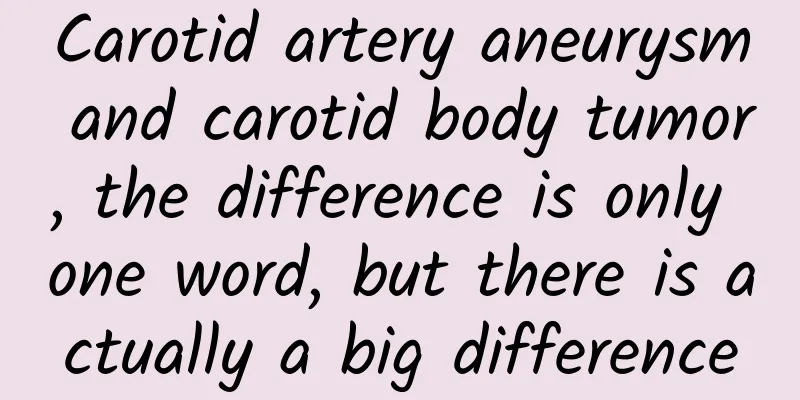Carotid artery aneurysm and carotid body tumor, the difference is only one word, but there is actually a big difference

|
Author: Liu Yumei, Chief Physician, Xuanwu Hospital, Capital Medical University Reviewer: Chief Physician of Huayang Capital Medical University Xuanwu Hospital Some people found a lump on their neck and went to the hospital for a checkup. The doctor said it was a carotid aneurysm. However, some people also had a lump on their neck, but the examination results showed that it was a carotid body tumor. What is the difference between "carotid aneurysm" and "carotid body tumor"? Figure 1 Copyright image, no permission to reprint 1. Differences between carotid artery aneurysm and carotid body tumor Carotid artery aneurysm and carotid body tumor, although these two diseases differ by only one letter, they are very different. Carotid artery aneurysm refers to the widening of the lumen and tumor-like bulging of the wall in the common carotid artery, internal carotid artery, external carotid artery and their branches. It is not a tumor growing inside the blood vessels. Carotid body tumor is a chemoreceptor tumor that occurs in the carotid body at the bifurcation of the common carotid artery through proliferation of the inner epithelial cells. Generally speaking, most of them grow slowly, but a few may have a tendency to become malignant. So specifically, what are the differences between the two? First, from the perspective of pathogenesis, common causes of carotid aneurysms include atherosclerosis, trauma, infection, etc., but the cause of carotid body tumors is still unclear. Currently, the medical community believes that its cause may be related to chronic hypoxia and genetic factors. Studies have shown that carotid body tumors are more common in people aged 40 to 50, with a higher incidence in women, and 40% of patients have a family genetic tendency. Secondly, from the perspective of clinical symptoms, carotid aneurysms will form vortex blood flow in the lumen, which is prone to blood cell aggregation and the formation of mural thrombi. If the thrombus breaks off and reaches the distal end, it may cause intracranial artery embolism, thereby causing abnormal blood supply to the brain, which in turn causes patients to experience dizziness, headaches, aphasia, hemiplegia and other stroke manifestations. Patients with carotid body tumors will not feel particularly obvious symptoms at first, but as the mass grows, tenderness will appear in the neck, and during this process, patients may experience compression symptoms in different parts of the body: if the internal carotid artery is compressed, dizziness and syncope will occur; if the throat is compressed, hoarseness will occur; if the trachea is compressed, breathing difficulties will occur. Figure 2 Copyright image, no permission to reprint Although both diseases appear as a raised mass, carotid aneurysms pulsate due to blood flow, while carotid body tumors do not pulsate. Therefore, imaging methods can be used to check whether the mass pulsates to distinguish between the two diseases. How to treat carotid artery aneurysms and carotid body tumors 1. Treatment of carotid artery aneurysm If the carotid aneurysm is too large, it may rupture, leading to bleeding in the carotid artery, causing suffocation or shock. Therefore, patients with confirmed carotid aneurysms should go to a hospital with treatment capabilities for targeted treatment as soon as possible. Due to the special location of the carotid artery, the treatment of carotid aneurysms has certain risks, and choosing the right surgical method is the key to successful treatment. (1) Surgical treatment: usually includes carotid aneurysm resection and end-to-end anastomosis, tumor resection and autologous vascular reconstruction, tumor resection + carotid artery ligation, carotid aneurysm contraction + external wrapping, etc. Doctors usually choose different surgical methods according to the size and location of the tumor: for smaller, free-standing carotid aneurysms, forceps will be placed on the neck to remove the tumor and suture it; if it is a fusiform carotid aneurysm, the aneurysm and diseased artery will be removed, and end-to-end anastomosis of the artery will be performed. Tumor removal and autologous vascular reconstruction may even be used, replacing the removed artery with an artificial blood vessel or the same artery; for dissecting carotid aneurysms, the diseased artery needs to be removed and the blood flow channel reconstructed with an artificial blood vessel. (2) Interventional therapy: Interventional therapy is usually considered for patients who are older or have other serious cardiovascular diseases and cannot tolerate surgery. This method does not require surgery. It only makes a small hole with a diameter of several millimeters in the blood vessel or skin. Under the guidance of imaging equipment, the covered stent and balloon are placed in the lesion area of the carotid artery to prevent blood flow from impacting the tumor in the lesion area, completely isolate the aneurysm cavity, form a thrombus in the tumor cavity, gradually occlude the aneurysm, and thus restore the blood flow of the carotid artery. 2. Treatment of carotid body tumors For patients with carotid body tumors, surgical treatment is generally adopted, and the following three surgical methods can be chosen. (1) Tumor dissection: After separating along the outer sheath of the carotid artery, the tumor is carefully separated from the blood vessels, and the tumor is removed, preserving the integrity of the carotid artery. (2) Tumor resection and vascular reconstruction: When the tumor and blood vessels cannot be separated, the tumor is malignant, or the third-level carotid body tumor surrounds the carotid bifurcation, the carotid bifurcation needs to be removed and the internal carotid artery needs to be reconstructed to ensure normal blood supply to the brain tissue after surgery. (3) Tumor resection and vascular ligation: If the tumor is huge and extends to the skull base, and the distal end of the carotid artery is difficult to separate or too short to perform vascular anastomosis to reconstruct the carotid artery, the only option is to ligate the internal carotid artery. Figure 3 Copyright image, no permission to reprint If you find a lump in your neck, you must pay attention to it and seek medical attention in time. Whether you are a patient with a carotid aneurysm or a carotid body tumor, you don’t need to be too nervous or worried. You must maintain a good attitude and actively cooperate with the doctor’s treatment to ensure the health and safety of your life. References [1] Yang Jin, Cai Hong, Yu Yuyu. Perioperative nursing of 13 cases of carotid body tumor[J]. Fujian Medical Journal, 2022, 44(2): 162-163. [2] Gao Weiren. Observation on the efficacy of endovascular intervention and open surgery in the treatment of peripheral pseudoaneurysm[J]. Imaging Research and Medical Application, 2022, 6(5):14-16. |
>>: Bathing your eyes in the sun, this sport will make protecting your eyesight more interesting
Recommend
Can ovarian cysts cause ectopic pregnancy?
There are many patients with ovarian cysts in our...
How to treat breast pain before menstruation
Many women suffer from headaches and breast pain ...
What are the nutritional values of pumpkin seeds? Are pumpkin seeds high in zinc?
Pumpkin seeds are an ideal high-nutrition snack b...
Causes of vaginal bleeding during bowel movements
Many people will find vaginal bleeding when defec...
What are the lifestyles that can harm your ovaries?
Women should protect themselves well in normal ti...
How long after menstruation is ovulation?
A woman's menstrual cycle generally includes ...
After the college entrance examination, be careful of the hidden things in seafood
After the college entrance examination, you can r...
Is a 21-day menstrual cycle normal?
Many women are rather casual in their diet during...
Female anal pain after sex
There is a kind of pain that occurs after sexual ...
How long after eating spicy food can I breastfeed?
Although it has always been emphasized that you s...
Why do I always get pregnant with a girl?
We all know that whether to have a boy or a girl ...
What to do to check for infertility
If you want to effectively treat infertility, you...
How many years can Tieguanyin be stored? How to buy Tieguanyin tea?
Tieguanyin is a very famous tea, and it is also t...









